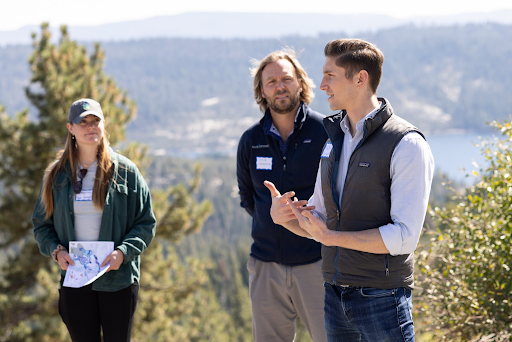Site Visit Recap | Upper Mokelumne Watershed


Blue Forest looks forward to continued work with UMRWA and our Mokelumne watershed partners to increase the pace and scale of this important forest restoration work to reduce risk of catastrophic wildfire and protect critical natural and utility infrastructure.
Written by: Annapurna Holtzapple, Project Associate
On October 13th, Blue Forest and our Upper Mokelumne River watershed partners visited the Eldorado National Forest to tour the area of the Forest Projects Plan (FPP). The project area has been untouched by catastrophic fire in recent years, but is in a region of the Sierra Nevada where many catastrophic fires, such as the Butte, Caldor, and Mosquito fires, have caused enormous damage to the landscape, communities, and economies. The Forest Projects Plan will safeguard and restore thousands of acres not yet burned that are overstocked and vulnerable to wildfire. In Phase 1 (a 26,000-acre subset of the larger project) fuels reduction treatments will be implemented to restore the landscape to a resilient state.
Upper Mokelumne watershed partners participating in the site visit included Eldorado National Forest, Upper Mokelumne River Watershed Authority (UMRWA), Pacific Gas and Electric (PG&E), East Bay Municipal Utility District (EBMUD), Amador Water Agency, Calaveras County Water District, World Resources Institute, and Blue Forest staff and science advisors. This group met at the Amador Ranger Station and made three stops to see an overlook of the landscape and Bear River Reservoir, a unit with active treatment, and important infrastructure in the forest matrix.

Our first stop was at the Peddler Hill Overlook, a vista point that looks out onto the forest, including treatment areas and a reservoir in the watershed. We had lunch accompanied by remarks from many of our attending partners, including an overview of treatments from UMRWA and Eldorado National Forest; an overview of project benefits, including water supply protection and fire risk reduction, from Dr. Roger Bales of UC Merced and the Sierra Nevada Research Institute; comments from several UMRWA member water agencies; and comments from PG&E. The group could also see different types of forest matrix from the vista and along the drive, including some FPP units and thinning treatments.

Next, the group continued up Highway 88 and onto some forest roads to meet up with the BurnBot crew contracted to implement treatments. BurnBot uses innovative restoration technology, differing from traditional methods of forest restoration by using unmanned equipment overseen by a field operator. Using this technology has several advantages, such as increasing the pace and scale of forest restoration by operating in steep terrain, using lighter equipment that causes less environmental damage from soil compaction, and dramatically increased fuel efficiency. During the site visit, we saw a demonstration of one of the team’s unmanned masticators to clear understory fuels.

Finally, the group passed through the town of Pioneer and down to the Tiger Creek Reservoir. We stopped near some important PG&E infrastructure and water conveyance systems. It was a clear demonstration of the low elevation, thick forest conditions, and dense fuel loads which make the landscape at high risk of catastrophic wildfire. This was a particularly important stop to emphasize the need for forest resilience and vulnerability of utility assets in and around the project, which will become more protected by the FPP restoration treatments.
Blue Forest looks forward to continued work with UMRWA and our Mokelumne watershed partners to increase the pace and scale of this important forest restoration work to reduce risk of catastrophic wildfire and protect critical natural and utility infrastructure. This site visit was an exciting opportunity to see the landscape, as well as how important this region is to downstream communities and ecosystem resilience.